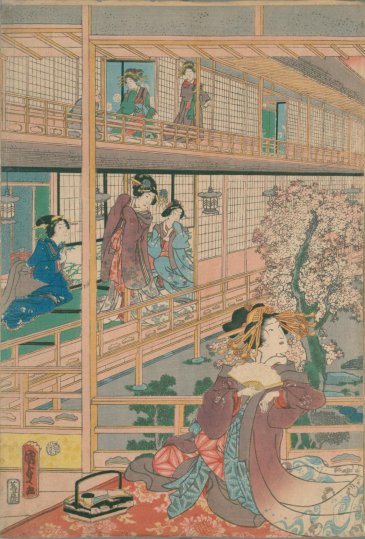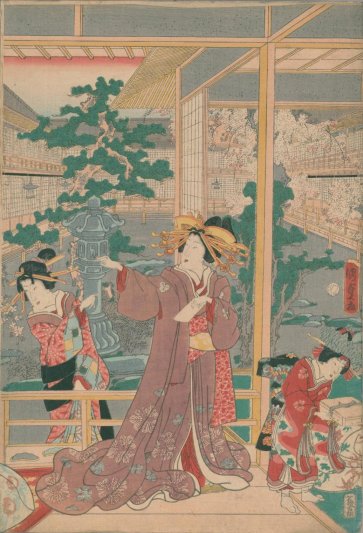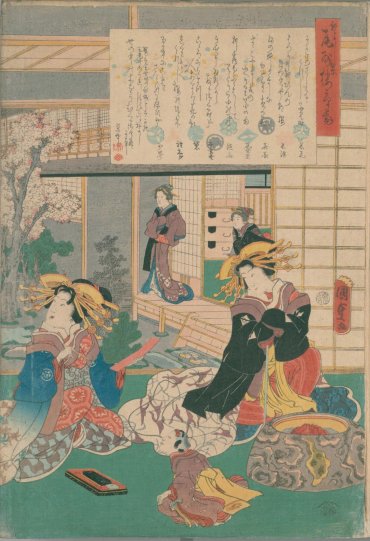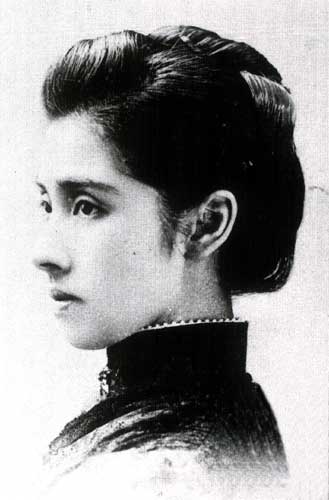

 新よし原尾州楼かり 国立国会図書館 所蔵
新よし原尾州楼かり 国立国会図書館 所蔵「芸者」は、手の込んだ「着物」を着て、「おしろい」で化粧をしていることが特徴的な日本髪の女性です。
“Geisha
「芸者」という言葉は、「芸術」を意味する「芸」と「人」または「行為者」を意味する「者」という2つの漢字で構成されています。
The word
“Geisha 芸者” consists of two “Kanji 漢字 Chinese character”, “Gei 芸” meaning “Art” and “Sha
者” meaning “Person” or “Performer”.
本来の「芸者」は、「武術」に秀でた男性でした。
The
original “Geisha 芸者” were men skilled in “Bu-gei 武芸 Martial arts”.
The “Bu-gei
Martial arts” have changed with the development of weapons such as “Yumi
Now, the most literal translation of “Geisha” into English would be “Art
Performer or Performing artist”.
「安土桃山時代(1573-1603)」末期から「江戸時代」初期に、派手な衣装や行動で人目を引くことが京都で流行しました。
From the
end of “Azuchi-Momoyama-jidai 安土桃山時代 Period
(1573-1603)” to the early “Edo-jidai 江戸時代 Period
(1603-1868)”, it was popular in Kyoto to get eye-catching with flashy costumes
and actions.
They
were called “Kabuki-mono かぶき者 Person” because of their “Kabuku 傾く” meanings of
unusual appearances and actions that would be noticeable.
And
there were “Yūjo 遊女 Performer or Prostitute” who set up a
stage on the riverbank of “Kamo-gawa 鴨川 River” in Kyoto and performed erotic dances and skits with wore costumes like “Kabuki-mono Person”.
They were
in charge of “Joyū 女優 Actress”, Dance performer, and Musicians combined with “Shōfu 娼婦 Prostitute”.
This new
performing art was called “Kabuki-odori 歌舞妓踊り Dance performance” or “Yūjo-kabuki 遊女歌舞妓 Play”, and spread throughout the country.
日本は伝統的に性的な喜びを受け入れていました。
Traditional
Japan embraced sexual delights.
「遊女」との性的楽しみを含むロマンチックな快楽は、「神道」や「仏教」のタブーではありませんでした。
Sexual enjoyment
and romantic attachment with “Yūjo Performer or Prostitute” are not taboo of
“Shinto
“Kuge 公家 Court noble”, “Bushi 武士 Samurai”, “Sōryo 僧侶 Monks” also enjoyed pleasure with “Yūjo Performer or Prostitute”.
In 1589,
“Toyotomi Hideyoshi 豊臣秀吉” designated “Yūri 遊里 Red-light district” in “Kyoto 京都”.
In 1590
(Tensho 18), “Toyotomi Hideyoshi” brought “Yūjo Performer or Prostitute” from
“Yūri” in Kyoto at “Odawara 小田原” at “Odawara-seibatsu
小田原征伐 Conquest”.
In the
same year, “Tokugawa Ieyasu 徳川家康” entered into “Edo-jō
江戸城 Castle.
「関ヶ原の戦い」を経て、1603(慶長8)年に「江戸幕府」が成立しました。
After “Sekigahara
no Tatakai 関ヶ原の戦い Battle”, “Edo Bakufu 江戸幕府 Shogunate” was established in 1603 (Keicho 8).
Not only
“Bushi 武士 Samurai”, but also many workers gathered from all over the country for
the construction of “Shuto Edo 首都江戸 Capital”.
After
the men, many “Yūjo Performer or Prostitute” came to Edo.
“Kensei-ya
傾城屋 Pleasure house” where hired “Yūjo Performer or Prostitute” were made in
various places.
「駿河」の「吉原宿」で「傾城屋」を営んでいた「庄司甚右衛門」も、江戸へやってきました。
“Shoji Jin-emon 庄司甚右衛門” who had run “Kensei-ya
In 1617
(Genwa 3), “Bakufu 幕府 Shogunate” licensed “Yūkaku 遊郭 Pleasure district” near “Nihombashi 日本橋”, with “Shoji Jin-emon 庄司甚右衛門” as “Nanushi 名主 Village head”.
そして、翌1618年に「吉原」の営業が始まりました。
And the
business at “Yoshiwara 吉原 Pleasure district” began in 1618.
The
highest class of “Yūjo Performer or Prostitute” were called “Tayū
“Tayū
Courtesan” and the early “Oiran Courtesan” were acquired arts and culture.


 新よし原尾州楼かり 国立国会図書館 所蔵
新よし原尾州楼かり 国立国会図書館 所蔵
In
addition, “Yūjo-Kabuki Play” was prohibited in 1629 (Kan-ei 6), and the actors
of “Kabuki” were sometimes called “Geisha 芸者 Performer”.
In “Genroku-nenkan 元禄年間 (1688-1704) Era”, a full-time
entertainers who made up for the lack of the performing arts of “Oiran
Courtesans” appeared in “Yoshiwara 吉原Pleasure district”.
And,
they were called “Geisha Performing artist”
女の「芸者」が「女芸者」、男の「芸者」が「男芸者」または「幇間」です。
The
female “Geisha” is “Onna-geisha 女芸者” and the male “Geisha”
is “Otoko geisha 男芸者” or “Hōkan 幇間”.
They entertained customers who was waiting the popular “Oiran Courtesan”
with dance performances, songs, games, music by “Shamisen 三味線” and others.
“Geisha Performing artist” was quite separated from “Oiran Courtesan” in
“Yoshiwara Pleasure district”.
“Geisha” who worked within “Yoshiwara Pleasure district” were strictly
forbidden from selling sex in order to protect the business of “Oiran Courtesan”.
They
worked with the performing arts such as “Shamisen 三味線”, “Koto 琴”, dance performances, songs and conversations.
“Oiran
Courtesans” plied their more carnal trade after “Geisha” finished their entertainment
at “Yoi no kuchi 宵の口 Early evening”.
「幕府」公認の「吉原」の他、「傾城屋」は「江戸四宿(品川、千住、板橋、内藤新宿)」にありました。
In addition to “Yoshiwara Pleasure district” licenced by “Bakufu
さらに、「岡場所」と呼ばれる違法な「傾城屋」が、門前町などにありました。
And, there
were an illegarl red-light districts called “Oka-basho
「江戸四宿」の宿では、「飯盛女」として多くの「遊女」を雇っていました。
The inns
at “Edo-shishuku Four-stations”, many prostitutes were hired as “Meshimori-onna
初めは、旅人がお客でしたが、やがて、江戸の「武士」や「僧侶」、町人がお客になりました。
At
first, travelers were customers, but eventually “Bushi 武士Samurai”, “Sōryo 僧侶 Monk”, and the
common people in Edo became customers.
「吉原」以外は、「芸者」と「花魁」の区別はあいまいでした。In addition to “Except “Geisha” who worked in “Yoshiwara Pleasure district”, the distinction between “Geisha” and “Oiran Courtesan” was fuzzy.
In
“Edo-jidai Period”, “Geisha” in “Fukagawa” comparable to “Yoshiwara”.
Because
“Fukagawa” was in direction of Edo's “Tatsumi 辰巳 Southeast”, They were called “Tatsumi geisha”.
There were “Geisha” who were proud of spirit “selling art performance but
not prostitute”.
They entertained their clients by dance performances, songs, and playing
music.
彼女たちは、芸能と博識に磨きをかけ、別のニッチを開拓し始めました。
Gradually, they became specialized new profession, purely of entertainment.
They
were lightly made up and hooked men’s “Haori 羽織 Japanese half-length coat” over in plain clothes, and went up to
“Zashiki 座敷 Japanese-style room” in “Ryōtei 料亭 High-class Japanese-style restaurant” with bare feet even in winter.
As a
stage name, they were given male name such as “Otokichi 音吉”, “Tsutakichi 蔦吉”, and “Mameyakko 豆奴”, and made a manly way of speaking.
These
seem to have aimed to disguise “Otoko-geisha 男芸者” and deceive the investigation of “Bakufu Shogunate”.
外出の際に左手で裾を引き上げる「左褄」の習慣は、伝統ある関西の「芸子」にまで影響を与えました。
The
custom of “Hidarizuma
 深川八幡牡丹 国立国会図書館 所蔵
深川八幡牡丹 国立国会図書館 所蔵
関西では「芸者」は「芸子」と呼ばれています。
The
Kansai version of “Geisha” is called by another name, “Geiko
The apprentices
of “Geiko” are called “Maiko 舞妓”.
After “Meiji-jidai Era”, “Geisha” was placed under the supervision of the
police, and “Geigi 芸妓” was used as the government term.
「芸者」や「遊女」などがいる地域は、「花街(かがい)」または「花柳(かりゅう)」と呼ばれていました。
The pleasure
district where “Geisha” and “Yūjo” work was called “Kagai
“Karyū”
is derived from “Huajieliuxiang 花街柳巷” in Chinese.
「芸者」たちが働く社会が、「花柳界」です。
The
society where “Geisha” works is “Karyū-kai 花柳界”.
“Kagai”
were also called “Sangyōchi 三業地 District” because “Sangyō 三業 Three business” of “Ryōri-ya 料理屋 Catere”, “Machiai-jaya 待合茶屋/料亭 Rental room/Ryōtei”,
and “Okiya 置屋” gathered.
In 1872
(Meiji 4), the “Geishōgi kaihō-rei 芸娼妓解放令 Release Order of Geisha and Yūjo” regulated the trafficking of “Shōgi 娼妓 Prostitutes” and the location of “Sangyōchi District”.
In the
diplomacy relations with Europe and the United States, it was indispensable to
attend the party with his wife.
“Geisha”
who is good at socializing and good-looking, has married as lawful wife with
the military and politicians, and were active in communication with foreigners.
“Itō Hirofumi
伊藤博文”, “Hara Takashi 原敬”, “Itagaki Taisuke
板垣退助”, “Inukai Tsuyoshi 犬養毅”, “Yamagata
Aritomo 山県有朋”, “Mutsu Munemitsu 陸奥宗光”, “Kido Takayoshi 木戸孝允”, “Inoue Kaoru 井上馨”, “Katsura Tarō 桂太郎” and so on are
married with “Geisha”.
 元新橋芸者 陸奥宗光妻おりう ウィキペディア
元新橋芸者 陸奥宗光妻おりう ウィキペディア
The
number of “Geisha” has increased as the political and business world uses
“Karyūkai”.
After
“Meiji 明治 Era”, “Geisha” in “Akasaka 赤坂” where is near “Nagatacho 永田町” and
“Kasumigaseki 霞が関”, had connections with politics.
多くの政治家は「料亭」での裏交渉で「芸者遊び」を楽しんだと言われています。
It is
said that many politics enjoyed “Geisha-asobi 芸者遊び Entertainment with Geisha” during behind-the-scenes negotiations at
“Ryōtei 料亭 Restaurant”.
「昭和」まで、政治家をはじめとするお金持ちが「芸者」を「妾」として囲うことも一般的でした。
Still
“Shōwa
“Geisha”
are organized into groups in “Kagai
“Kenban
Offices” organize and coordinate the schedules of “Geisha”, and arrange “Geisha”
only at designated “Ryōtei Restaurant”.
Once, “Yanagibashi
柳橋”, “Yoshimachi 芳町”, “Shinbashi 新橋”, “Akasaka 赤坂”, “Kagurazaka 神楽坂”, “Asakusa 浅草” were called
“Roku-kagai 六花街”.
And “Mukōjima
日本の伝統的な「舞踊」は、「舞い」・「踊り」・「振り」の三要素によって構成されています。
Japanese
traditional “Buyō 舞踊Dance” is composed of three elements: “Mai
舞い”, Odori 踊り”, and “Furi 振り”.
「舞い」は、荘重な歌や音楽に合わせて、摺り足や静かな動作が特長です。
“Mai”
features sliding feet and quiet movements to majestic songs and music.
心の内面を水平的な動作で表現し、呪術的要素が強く、貴族社会の舞台芸能として長い歴史を持ちます。
It
expresses the inner surface of the mind in a horizontal motion, has a strong
magical element, and has a long history as a performing art for aristocratic
society.
「踊り」は、軽快な歌や音楽に合わせて、肉体的動作で特定の意味を律動的に表現します。
“Odori”
expresses a specific meaning rhythmically with physical movements to light
songs and music.
「踊り」は、新仏教の興隆とともに特に「鎌倉時代」になって発達しました。“Odori” developed with the rise of New Buddhism, especially during the “Kamakura-jidai Period”.
「振り」は、歌や音楽に合わせて、日常的な動きやしぐさを舞踊として表現するものです。“Furi” expresses daily movements and gestures as dances along with songs and music.
「振り」は、演劇的要素が強く、「江戸時代」に「歌舞伎」や「人形浄瑠璃」の発達にともなって派生しました。“Furi” has a strong theatrical element and was derived in the “Edo-jidai Period” with the development of “Kabuki” and “Ningyō Jōruri”.
音曲には、三味線をはじめ横笛や太鼓が使用されます。
The
music uses “Shamisen”, “Yoko-bue 横笛 Flute” and “Taiko 太鼓 Drum”.
おしろい(白粉)は、役者や女性が顔や首筋などに塗布して肌を色白に見せるために使用する化粧品です。
“Oshiroi
白粉 White powder” is a cosmetic used by actors and women to apply to
the face and nape to make the skin look pale.
日本では、7世紀ごろに中国から白粉がもたらされ、国産化されました。
In
Japan, “Oshiroi White powder” was brought from China around the 7th century and
made domestic.
白粉に鉛白が使用されていたため、日常的に使用する役者は、鉛中毒で死亡する事例もありました。
Since
white lead was used in “Oshiroi White powder”, actors who use it on a daily
basis died of lead poisoning.
1934(昭和9)年には、鉛を使用した白粉の製造が禁止されました。
In 1934
(Shōwa 9), production of “Oshiroi White powder” using lead was banned.